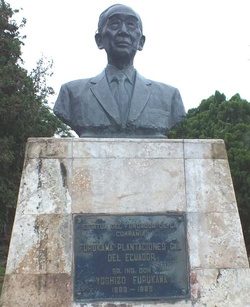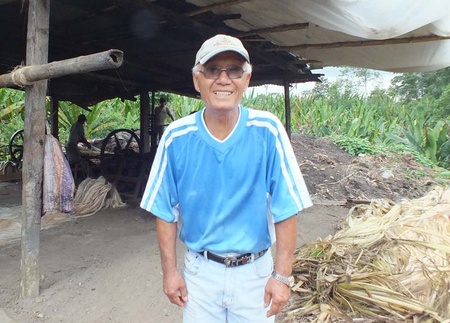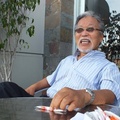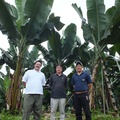= Pre-war Davao revived through a strange coincidence = People from Suzano also settled there
Men who inherited the passionate aspirations of Japanese immigrants from before the war emigrated to Ecuador. Ecuador is said to have few Japanese immigrants, even among South America, and no national policy on immigration. However, after the war, Furukawa Takushoku Co., Ltd. started its business with a loan from the Japan Overseas Emigration Promotion Co., Ltd. We followed the little-known abaca business of "Furukawa Takushoku" and the current situation of the Japanese farmers involved in it.
After a three-hour drive from Quito, the capital at an altitude of 2,800 meters, and heading west while clearing your ears many times along the way, you enter the department of Santo Domingo de los Tsachilas. In the department capital, Santo Domingo de los Colorados, commonly known as "Santo Domingo," three-wheeled moto taxis, which are not seen in Quito, run around, and the stuffy air makes you feel as if you have arrived in a country somewhere in Asia.
From there, we drove further in along an unpaved road for 40 minutes past abaca and palm plantations, and then for 20 minutes, until we suddenly came across an open space with neatly trimmed grass.
The letters that represent grass are "FPC" (Furukawa Plantacions CA). It stands for Furukawa Takushoku, who established the largest Japanese community in the South Seas in Davao, Mindanao Island in the southern Philippines before the war. The company was established in Davao in 1914 by Yoshizo Furukawa (1888-1985), and began cultivating abaca, also known as "Manila hemp."
At that time, the Japanese abaca industry in the Philippines, led by this company, showed remarkable growth. In the late 1930s, 20,000 Japanese people lived in Davao, and abaca became the country's main agricultural export product, ranking first in total exports. However, after Japan lost the war, all the assets of Filipino immigrants were confiscated and they were forcibly repatriated...
After the war, immigration policies were finally resumed. At the request of the Japanese government, Furukawa, who was already 70 years old, visited the Amazon in 1959. Near Quevedo, Ecuador, where the conditions for abaca growth were met, Furukawa inspected an experimental farm where abaca had been planted by the United States.
The seedlings were the descendants of the ones that Furukawa had sent from Davao to the United States in 1925. This strange coincidence led to Ecuador being chosen as the site for the revival of abaca cultivation.
When it became known that Takushoku Furukawa was reviving the abaca business in Ecuador, many of the powerful men from the Davao era came forward one after another. Some of them had already emigrated to Brazil, but several families relocated there, driven by their passion for abaca.
Masaru Hanzawa (71) is one of them. His father, the late Kaneshige, worked for Furukawa Takushoku when it was in Davao, and Masaru was born in Davao. After the evacuation, he lived in Fukushima, but after the war he emigrated to Brazil on the Santos Maru in 1962. He settled in Suzano, São Paulo, where he raised chickens and grew vegetables.
However, five years later, Furukawa came to Brazil to recruit people interested in moving to Ecuador, and after seeing an advertisement in a Japanese newspaper, the family decided to move to Ecuador.
"Eh esquesi Portuguese?" says Hanzawa, laughing heartily as he stomps through the abaca forest, still in active duty.
= Almost the same work as in Davao = Relying on mules and human eyes and hands
"I've gotten into the habit of always looking up when I walk," says Masaru Hanzawa, walking through a plantation of cut-down abaca with unstable footing. He looks up to see if there are any flowers about to bloom. Apparently, the most flexible fibers can be extracted right after the flowers bloom.
The amount of fiber that can be extracted varies depending on the thickness of the stalk, so select stalks that always have the same amount of fiber when cut.
The process of cutting off excess leaves before felling the stem is called "sonke." A long-handled sickle-like tool called a sonke is used.
"Tumba" means to cut down the stem. Although it is called a stem, it is about 3 meters tall and 20 centimeters thick, so it seems that the tree will fall.
Once he has all three stalks together, he skillfully creates a base out of the unused stems, then selects only the fibrous parts of the leaf sheaths and peels them off starting from the base.
The only tool used is a hatchet-like blade called a tuxeiro, which comes from the word "tuxe," meaning the act of peeling.
The leaf sheaths being peeled off bend and groan like a long whip. It's an elegant process that is fun to watch, but it's also very laborious.
The fibers are reddish brown on the outside and whiter and more flexible as they go inwards, resulting in higher grades.
The next step is to transport the bundles to the hemp-pulling area by mule called a brero. Up to this point, everything is done within the plantation, and the remains of the fallen stalks are left there to be used as fertilizer.
Like bananas, abaca stems grow continuously from the remaining roots, so there is no need to replant them.
The bundles of leaf sheaths carried by the mules, called "tonguillos," are turned black with oil into fiber by a hemp-pulling machine called "hagotan," a machine invented by a Japanese person in Davao.
Although it is called a machine, it is a simple mechanism in which a file is rotated by a motor, and a person wraps the leaf sheath around the file and removes the leaf flesh.
"The hemp (fiber) is so strong that if you wrap it around your hands or feet, it will just take you away. Hehehe!" His hearty laughter gives us a glimpse into the long history of the abaca industry.
For efficiency, mules are the best way to transport goods around plantations where the ground is uneven and the plants are not planted in rows.
They rely on human eyes and hands to separate the hemp that has been dragged by the mules and has garbage mixed in. As a result, not only the language but also the work itself has hardly changed since their time in Davao.
Now independent, Hanzawa produces abaca on 43 hectares and bananas on 22 hectares, and supplies them to Japanese companies ABAUDESA and TECNOBAN, respectively.
"I used to enjoy mahjong, but there are no Japanese people playing it anymore. Now I enjoy drinking whiskey at night."
Behind Hanzawa, abaca plants drying like somen noodles were swaying in the wind.
*This article is reprinted from the Nikkei Shimbun (published September 14th and 17th, 2013).
© 2013 Nikkey Shimbun











